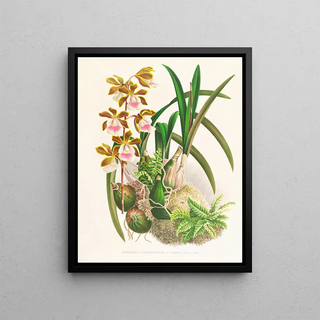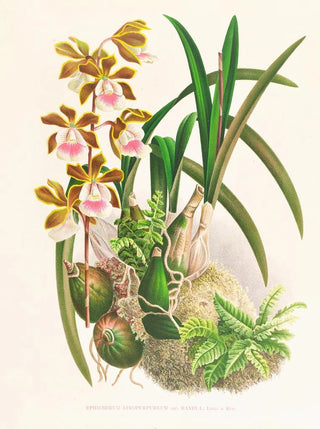Art print | Épidendrum atropurpureum - Jean Jules Linden


View from behind

Frame (optional)
Épidendrum atropurpureum - Jean Jules Linden – Captivating introduction
The artwork "Épidendrum atropurpureum" by Jean Jules Linden is much more than a simple floral representation; it is an immersion into a world where natural beauty blends with art. This painting, which captures the essence of a rare orchid, evokes a delicacy and chromatic richness that transport the viewer into a lush garden. Through its meticulous brushstrokes, Linden manages to bring each petal, each leaf, to life, thus revealing the magic of nature in all its splendor. This piece, emblematic of the 19th-century naturalist movement, embodies an era when careful observation of nature was at the heart of artistic creation.
Style and uniqueness of the work
Jean Jules Linden's style is characterized by botanical precision combined with a keen sense of aesthetics. In "Épidendrum atropurpureum," the artist uses a palette of vibrant colors, ranging from deep violet shades to bright green nuances. This chromatic harmony is not limited to the visual aspect; it also evokes emotions and sensations, immersing the viewer in an almost meditative contemplation. The composition of the work, carefully balanced, highlights the majesty of the flower while maintaining a subtle background that emphasizes its presence. Far from being a simple botanical painting, this piece transcends the genre to become a true ode to nature, where every detail is celebrated with almost religious attention.
The artist and his influence
Jean Jules Linden, born in Brussels in 1817, is recognized as one of the greatest floral artists of his time. His passion for botany and his commitment to faithful plant representation made him a pioneer in the field of floral art. Influenced by Romantic and naturalist movements, Linden knew how to combine science and art, creating works that are both informative and aesthetic. His work had a major impact on the perception of nature in art, inspiring many contemporary artists to explore themes of flora and fauna. Through his creations, he paved the way for a new appreciation of natural beauty, encouraging reflection on our

Matte finish

View from behind

Frame (optional)
Épidendrum atropurpureum - Jean Jules Linden – Captivating introduction
The artwork "Épidendrum atropurpureum" by Jean Jules Linden is much more than a simple floral representation; it is an immersion into a world where natural beauty blends with art. This painting, which captures the essence of a rare orchid, evokes a delicacy and chromatic richness that transport the viewer into a lush garden. Through its meticulous brushstrokes, Linden manages to bring each petal, each leaf, to life, thus revealing the magic of nature in all its splendor. This piece, emblematic of the 19th-century naturalist movement, embodies an era when careful observation of nature was at the heart of artistic creation.
Style and uniqueness of the work
Jean Jules Linden's style is characterized by botanical precision combined with a keen sense of aesthetics. In "Épidendrum atropurpureum," the artist uses a palette of vibrant colors, ranging from deep violet shades to bright green nuances. This chromatic harmony is not limited to the visual aspect; it also evokes emotions and sensations, immersing the viewer in an almost meditative contemplation. The composition of the work, carefully balanced, highlights the majesty of the flower while maintaining a subtle background that emphasizes its presence. Far from being a simple botanical painting, this piece transcends the genre to become a true ode to nature, where every detail is celebrated with almost religious attention.
The artist and his influence
Jean Jules Linden, born in Brussels in 1817, is recognized as one of the greatest floral artists of his time. His passion for botany and his commitment to faithful plant representation made him a pioneer in the field of floral art. Influenced by Romantic and naturalist movements, Linden knew how to combine science and art, creating works that are both informative and aesthetic. His work had a major impact on the perception of nature in art, inspiring many contemporary artists to explore themes of flora and fauna. Through his creations, he paved the way for a new appreciation of natural beauty, encouraging reflection on our






